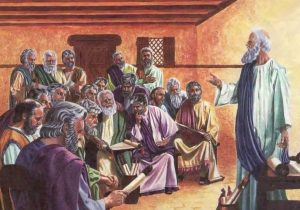 The initial Christian movement was 99.9% Jewish and Samaritan for the first 10 years. As such, they saw themselves as being
The initial Christian movement was 99.9% Jewish and Samaritan for the first 10 years. As such, they saw themselves as being
followers of Messiah and still kept the Torah laws. Most people don’t realize, but it was the conflict with the Jewish
leadership, not the gentiles, which began separating Christian Jews from Torah observance.
There were some within the Church who insisted on Circumcision for new believers (gentiles). And there were many outside the church who shut the synagogues to the Christians.
Jesus had made it clear in John 4 (and I would say so in His teachings at other times) that the new coming of the Kingdom meant that God was no longer going to restrict people to strict Torah observance, but to obedience from the heart – once the Spirit had come. (Hence “in spirit and truth”). This was a fulfillment of the promise of Jeremiah that the Messiah would bring a “new covenant”.
That threatened the Sadducees and Pharisees who made a really fat living off animal Sacrifices in the Temple, and teaching and adjudicating under Torah. So, they threw the Christians out of Synogogues and prevented them from worshiping at the Temple. Thus, Christians (Jewish believers in Jesus) were now excluded from their society and became very poor for the sake of the Kingdom. (Which is why Paul was raising funds for the church from Gentiles).
Peter wrote his first letter to explain that this would be necessary for the Jewish church to endure.
So, it was not the gentile believers, but the Judaizers and the hostile non-believing Jews who brought about the break from customs. Because the Jewish Christians had nowhere else to turn for commerce, trade, etc but to the Roman businesses and services the needed to buy and sell.
Thus early Christianity broke from Judaism on multiple levels. As Jesus said, it caused family and society to break up.
Early Christian communities and heritage
followers of Messiah and still kept the Torah laws. Most people don’t realize, but it was the conflict with the Jewish
leadership, not the gentiles, which began separating Christian Jews from Torah observance.
There were some within the Church who insisted on Circumcision for new believers (gentiles). And there were many outside the church who shut the synagogues to the Christians.
Jesus had made it clear in John 4 (and I would say so in His teachings at other times) that the new coming of the Kingdom meant that God was no longer going to restrict people to strict Torah observance, but to obedience from the heart – once the Spirit had come. (Hence “in spirit and truth”). This was a fulfillment of the promise of Jeremiah that the Messiah would bring a “new covenant”.
That threatened the Sadducees and Pharisees who made a really fat living off animal Sacrifices in the Temple, and teaching and adjudicating under Torah. So, they threw the Christians out of Synogogues and prevented them from worshiping at the Temple. Thus, Christians (Jewish believers in Jesus) were now excluded from their society and became very poor for the sake of the Kingdom. (Which is why Paul was raising funds for the church from Gentiles).
Peter wrote his first letter to explain that this would be necessary for the Jewish church to endure.
So, it was not the gentile believers, but the Judaizers and the hostile non-believing Jews who brought about the break from customs. Because the Jewish Christians had nowhere else to turn for commerce, trade, etc but to the Roman businesses and services the needed to buy and sell.
Thus early Christianity broke from Judaism on multiple levels. As Jesus said, it caused family and society to break up.
Published in Church History, Commentary and Teaching